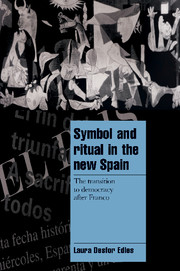Book contents
- Frontmatter
- Contents
- List of tables
- List of figures
- List of abbreviations
- Acknowledgements
- Map of Spain
- Part I Interpreting the Spanish transition to democracy
- Part II The symbolic basis of Spanish consensus
- 4 The spirit of consensus: the core representations of the Spanish transition
- 5 The curtain rises: the first democratic elections
- 6 The 1977 Moncloa Pacts and the ritualization of communality
- Part III Conflict and consensus in the institutionalization of Spanish democracy
- Notes
- References
- Index
5 - The curtain rises: the first democratic elections
Published online by Cambridge University Press: 06 July 2010
- Frontmatter
- Contents
- List of tables
- List of figures
- List of abbreviations
- Acknowledgements
- Map of Spain
- Part I Interpreting the Spanish transition to democracy
- Part II The symbolic basis of Spanish consensus
- 4 The spirit of consensus: the core representations of the Spanish transition
- 5 The curtain rises: the first democratic elections
- 6 The 1977 Moncloa Pacts and the ritualization of communality
- Part III Conflict and consensus in the institutionalization of Spanish democracy
- Notes
- References
- Index
Summary
The first democratic elections since 1931 were held in Spain on June 15, 1977. The Union of the Democratic Center (Unión del Centra Democrático, UCD) and the Spanish Socialist Workers' Party (Partido Socialista Obrero Español, PSOE) received almost 63 percent of the votes cast, and over 80 percent of the seats in the lower house (Congress of Deputies) of the constituent Cortes. The center/center-right UCD secured 34 percent of the popular vote and controlled 165 seats in the Congress of Deputies, just 11 short of an absolute majority. The socialist PSOE emerged as the principal opposition party, with 28.9 percent of the vote and 118 seats. Two other political groups, the Spanish Communist Party (Partido Comunista Español, PCE) and the conservative Popular Alliance (Alianza Popular, AP) earned enough votes to ensure themselves a significant role in the new parliament. The remaining few seats were distributed among smaller parties, most importantly, the Catalan Democrats (Pacte Democrátic per Catalunya, PDC), which received 11 seats, and the Basque Nationalist Party (Partido Nacionalista Vasco, PNV), which received 8 seats. Complete electoral results can be found in Table 5.1.
The 1977 election results were most surprising in the poor showing of both the Christian Democrats and Alianza Popular (AP). A poll conducted in January 1977 found that the Christian Democrats were by far the most favored political group in Spain.
- Type
- Chapter
- Information
- Symbol and Ritual in the New SpainThe Transition to Democracy after Franco, pp. 63 - 80Publisher: Cambridge University PressPrint publication year: 1998

